Bertrand Piccard is no conventional environmental activist — he hopes to raise awareness about the potential of renewable energy by flying a solar-powered aircraft around the world.
“What we want to do is to fly day and night to show that, with renewable energies, you can have unlimited duration of flight, no restriction,” Piccard said at the World Future Energy Summit in Abu Dhabi, where he had a booth to promote his venture.
The 51-year-old Swiss psychiatrist plans to fly his one-of-a-kind Solar Impulse around the world over 20 to 25 days, traveling at an average of 70kph.
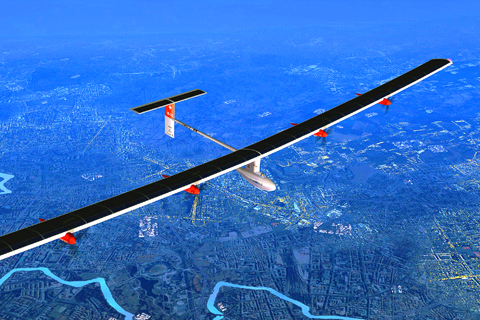
PHOTO: AFP
He will split the flying time with Andre Borschberg, a former Swiss fighter pilot.
“We believe that if an airplane can fly around the world with no fuel, nobody can say after that it’s impossible to do it for cars, for heating systems, for air-conditioning, for computers and so on,” he said.
The prototype of Solar Impulse made its first test flight near Zurich last month. The plane is made of carbon fiber, with solar panels along the top of its roughly 64m wingspan.
The aim is for the solar panels to absorb energy to power the aircraft during the day and at the same time store energy in lithium polymer batteries to run the engines at night.
After aircraft manufacturers said Piccard’s specifications would be impossible to meet, he turned to a racing yacht manufacturer to build the airframe.
“They did not know it’s impossible, so they did it,” he said.
The plane is powered by four electric engines, each making a maximum of 10 horsepower. Piccard said that despite having a wingspan close to that of an Airbus A340, Solar Impulse weighs only 1,600kg.
Asked what led him to try this unorthodox method of promoting renewable energy, Piccard pointed to his family history.
“I come from a family of explorers who always had a lot of concern for the environment and for natural resources,” he said. “My grandfather was the first man to explore the stratosphere, to climb above the atmosphere [in a balloon] ... and my father made in 1960 the deepest dive ever in a submarine,” he said.
Piccard has already demonstrated a penchant for adventure. In 1999, he and Briton Brian Jones became the first men to complete a non-stop flight around the globe in a hot-air balloon.
That flight “gave me the fame to ... do useful things,” Piccard said, including finding sponsors, money and support for his current project.
The project, which will cost a total of 70 million euros (US$100 million), has been under way for about seven years and still has a way to go. The attempted flight around the world won’t take place until 2012 or 2013.
This year, the aircraft will undergo high-altitude testing and will also be tested in daytime and nighttime flight. If that goes well, the prototype will either be modified or a new one built for a trans-Atlantic flight.
“We have to reproduce Lindbergh’s flight with no fuel,” Piccard said, referring to Charles Lindbergh, the first man to fly across the Atlantic Ocean.
The one-man aircraft will land at different points during the flight around the world so the pilots can switch off, Piccard said.
In addition to the switch, the landings will be an opportunity “to present the technology of this airplane, to encourage people to use [the technology] also, for their daily life,” he said.
For Piccard, the Solar Impulse project is a new, positive tack in promoting renewable energy and conservation.
“I was in Copenhagen [for the recent climate change conference], and I see people are fed up with the alarmists, the catastrophists,” he said. “People need solutions, not problems. So we have to demonstrate the solutions. We have to show that it’s possible to do great things.”
And aviation, Piccard said, is “a good vector to push messages.”
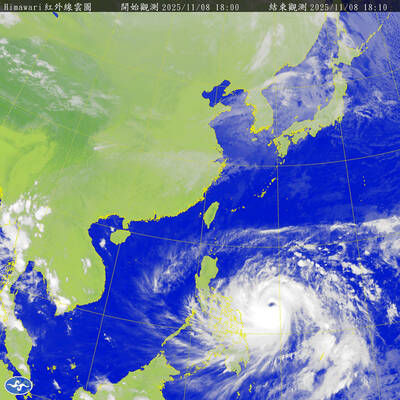
The Central Weather Administration (CWA) yesterday said it expected to issue a sea warning for Typhoon Fung-Wong tomorrow, which it said would possibly make landfall near central Taiwan. As of 2am yesterday, Fung-Wong was about 1,760km southeast of Oluanpi (鵝鑾鼻), Taiwan’s southernmost point, moving west-northwest at 26kph. It is forecast to reach Luzon in the northern Philippines by tomorrow, the CWA said. After entering the South China Sea, Typhoon Fung-Wong is likely to turn northward toward Taiwan, CWA forecaster Chang Chun-yao (張峻堯) said, adding that it would likely make landfall near central Taiwan. The CWA expects to issue a land
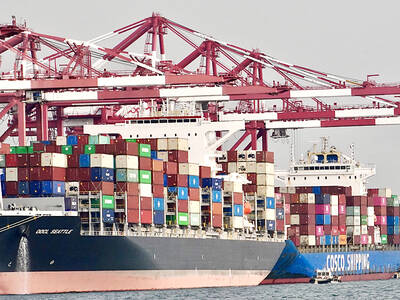
Taiwan’s exports soared to an all-time high of US$61.8 billion last month, surging 49.7 percent from a year earlier, as the global frenzy for artificial intelligence (AI) applications and new consumer electronics powered shipments of high-tech goods, the Ministry of Finance said yesterday. It was the first time exports had exceeded the US$60 billion mark, fueled by the global boom in AI development that has significantly boosted Taiwanese companies across the international supply chain, Department of Statistics Director-General Beatrice Tsai (蔡美娜) told a media briefing. “There is a consensus among major AI players that the upcycle is still in its early stage,”
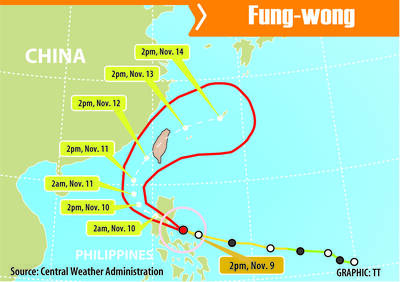
The Central Weather Administration (CWA) yesterday said it is expected to issue a sea warning for Typhoon Fung-wong this afternoon and a land warning tomorrow. As of 1pm, the storm was about 1,070km southeast of Oluanpi (鵝鑾鼻), Taiwan’s southernmost point, and was moving west-northwest at 28 to 32kph, according to CWA data. The storm had a radius of 250km, with maximum sustained winds of 173kph and gusts reaching 209kph, the CWA added. The storm is forecast to pass near Luzon in the Philippines before entering the South China Sea and potentially turning northward toward Taiwan, the CWA said. CWA forecaster Chang Chun-yao (張峻堯) said
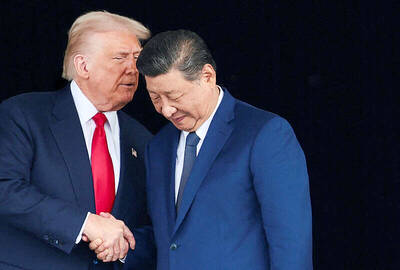
‘SECRETS’: While saying China would not attack during his presidency, Donald Trump declined to say how Washington would respond if Beijing were to take military action US President Donald Trump said that China would not take military action against Taiwan while he is president, as the Chinese leaders “know the consequences.” Trump made the statement during an interview on CBS’ 60 Minutes program that aired on Sunday, a few days after his meeting with Chinese President Xi Jinping (習近平) in South Korea. “He [Xi] has openly said, and his people have openly said at meetings, ‘we would never do anything while President Trump is president,’ because they know the consequences,” Trump said in the interview. However, he repeatedly declined to say exactly how Washington would respond in